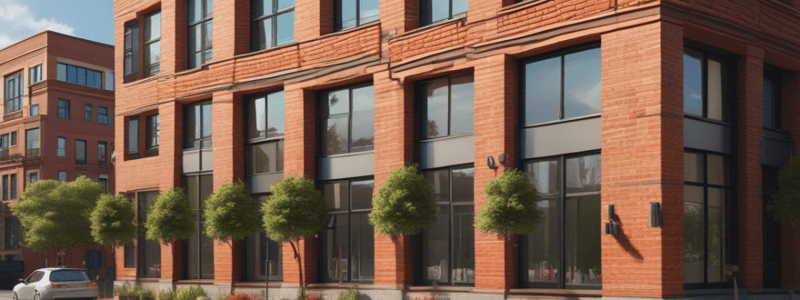Podcast
Questions and Answers
What is a critical aspect of ensuring energy efficiency and reducing environmental impact in built environments?
What is a critical aspect of ensuring energy efficiency and reducing environmental impact in built environments?
- Improving user health and productivity
- Focusing on deep renovations (correct)
- Optimizing the processes involved
- Characterizing building interiors
Why is implementing changes at city levels important for renovation strategies?
Why is implementing changes at city levels important for renovation strategies?
- To limit the scope of renovation projects
- To promote more ambitious goals (correct)
- To reduce the cost of renovations
- To increase the use of traditional materials
Which element is a key focus for improving energy efficiency and space comfort simultaneously?
Which element is a key focus for improving energy efficiency and space comfort simultaneously?
- Interior design
- Building foundations
- Roofs
- Façades (correct)
What is necessary to establish behavior patterns and improve maintenance processes of building facades?
What is necessary to establish behavior patterns and improve maintenance processes of building facades?
Why is it important to move cities beyond 'business-as-usual' paradigms in renovation efforts?
Why is it important to move cities beyond 'business-as-usual' paradigms in renovation efforts?
How can focusing on early adopter buildings help encourage deep renovations?
How can focusing on early adopter buildings help encourage deep renovations?
Which directive does the text mention that emphasizes energy efficiency renovations?
Which directive does the text mention that emphasizes energy efficiency renovations?
What is often considered within the context of energy efficiency renovations?
What is often considered within the context of energy efficiency renovations?
What do authors like Delmastro et al. propose to classify existing structures?
What do authors like Delmastro et al. propose to classify existing structures?
What can categorizing existing structures using Reference Buildings provide, according to the text?
What can categorizing existing structures using Reference Buildings provide, according to the text?
What do recent trends in design lean towards, according to the text?
What do recent trends in design lean towards, according to the text?
What is the ultimate goal of the strategies mentioned in the text?
What is the ultimate goal of the strategies mentioned in the text?
Study Notes
Renovating existing buildings is a critical aspect of ensuring energy efficiency and reducing environmental impact of our built environments. By focusing on deep renovations, we can significantly enhance the sustainability of these structures while maintaining important connections between interior and exterior elements like façades.
A key factor in renovation strategies is optimizing the processes involved. This means implementing changes at city levels to promote more ambitious goals, leading to resilient, livable, environmentally friendly buildings. Improvements in user health and productivity are also crucial outcomes of deep renovations.
One significant area of focus is on façades. Given that there are approximately 60 billion square meters of façade surfaces, a dedicated chapter on facade renovations could serve as a vital tool for addressing energy efficiency and space comfort simultaneously. Through proper characterization of a building's façade, it becomes possible to establish behavior patterns and improve maintenance processes. This requires a clear framework guiding long-term plans and support for moving cities beyond 'business-as-usual' paradigms.
To encourage deep renovations, several approaches have been suggested:
-
Strategic Interventions: Focusing on early adopter buildings that demonstrate high replicability and scalability can help increase the exponential impact of deep renovations. These examples can inspire other urban areas to initiate similar processes.
-
Cost-Effective Perspective: European Union's Energy Performance of Buildings Directive (EPBD) emphasizes energy efficiency renovations using either a cost-effective or disruptive approach. Envelope renovation, which includes façade work, is often considered within this context.
-
Defining Building Archetypes: Authors such as Delmastro et al. propose identifying Reference Buildings, serving as benchmarks to classify existing structures. This categorization can provide an initial assessment of potential energy savings post-façade renovations, along with broader benefits concerning health, safety, and air quality.
-
User-Centered Design: Recent trends lean towards designs that prioritize user needs and preferences. Engaging users effectively can lead to greater acceptance and impact on energy consumption reduction in buildings.
These strategies aim to facilitate deep renovations in existing buildings, ultimately contributing to enhanced energy efficiency, improved indoor conditions, and overall environmental sustainability.
Studying That Suits You
Use AI to generate personalized quizzes and flashcards to suit your learning preferences.
Description
Explore key strategies for deep renovations in existing buildings with a focus on façade improvements to enhance energy efficiency and indoor comfort. Learn about approaches such as strategic interventions, cost-effective perspectives, defining building archetypes, and user-centered design to promote environmental sustainability.




